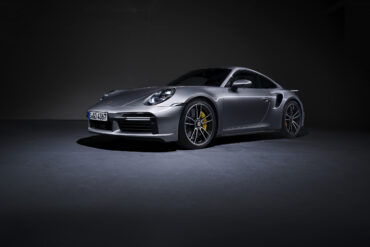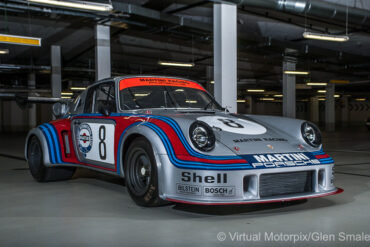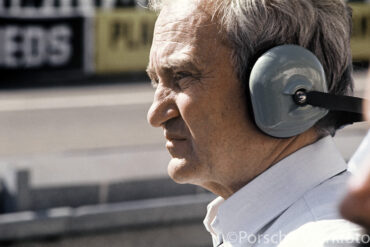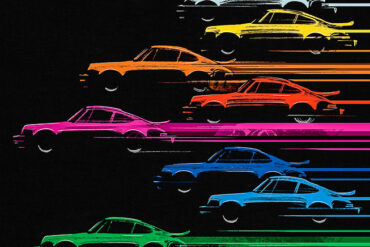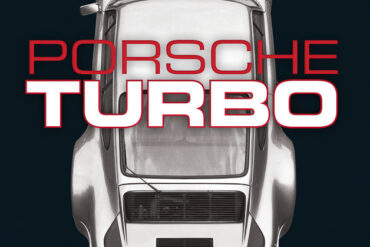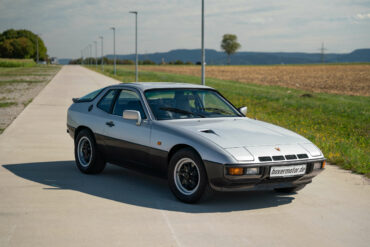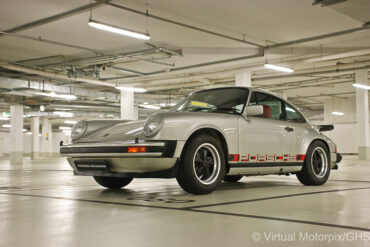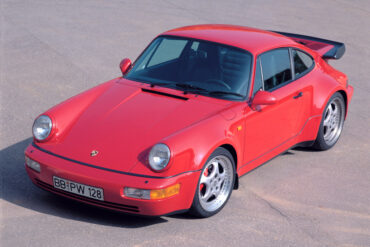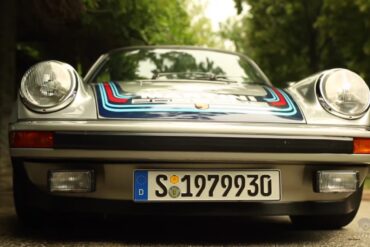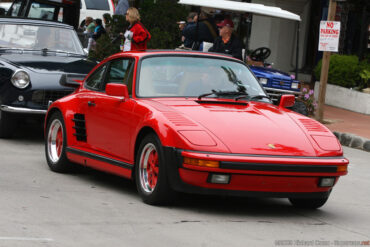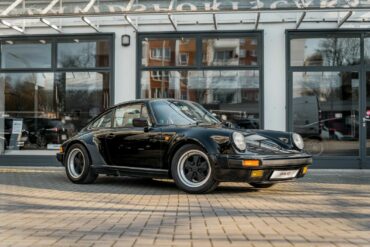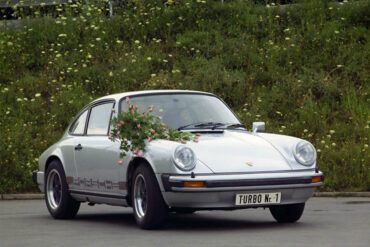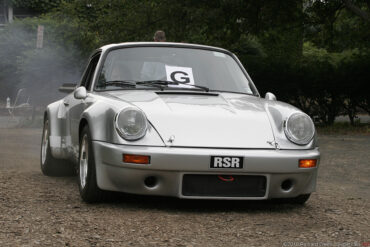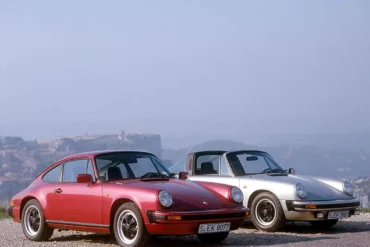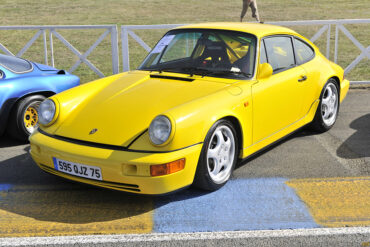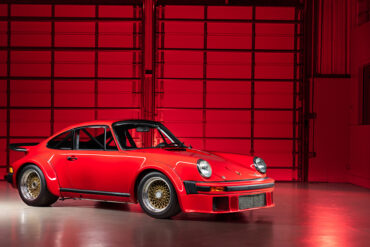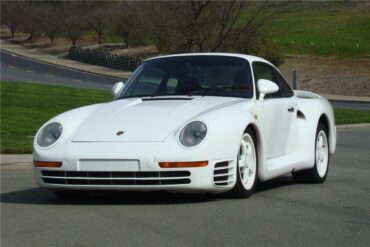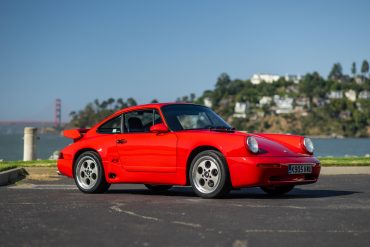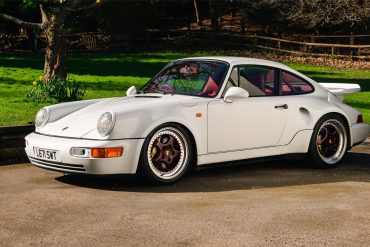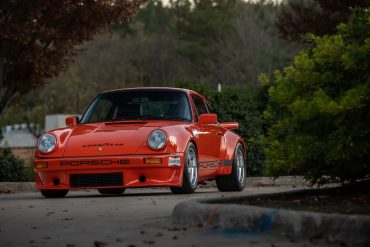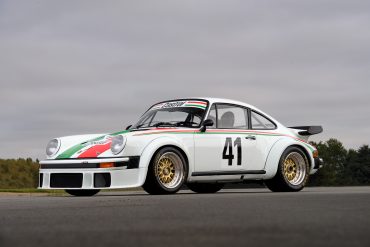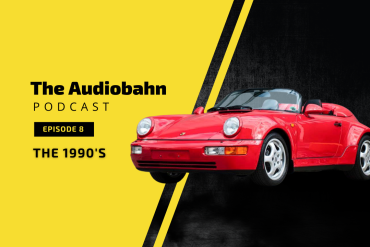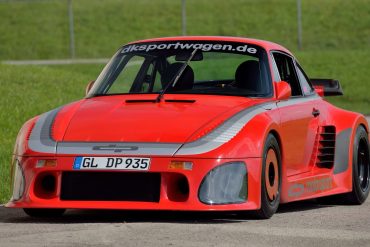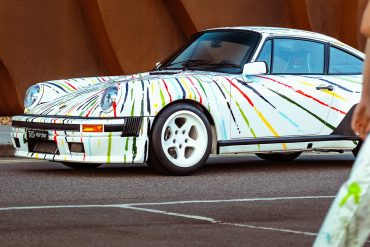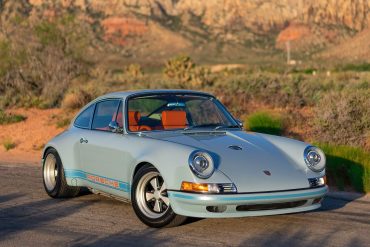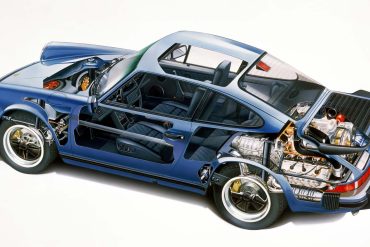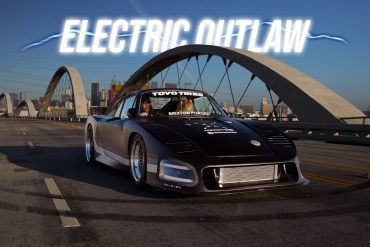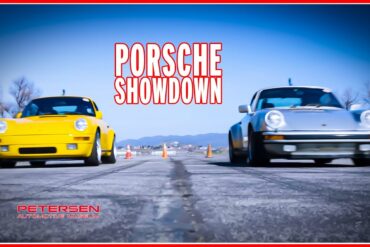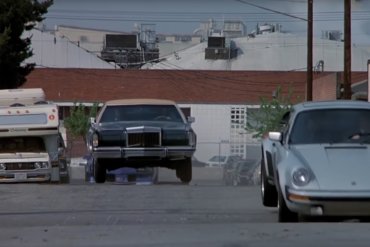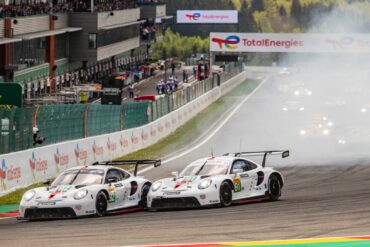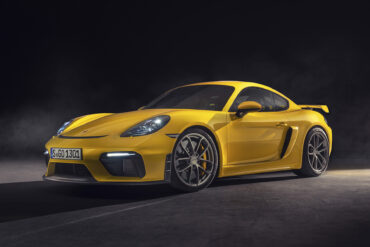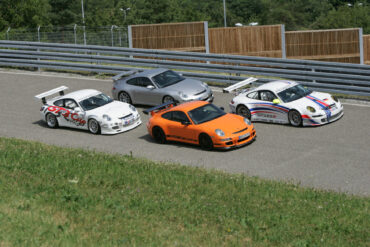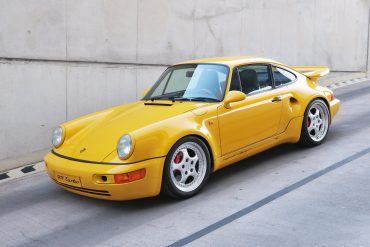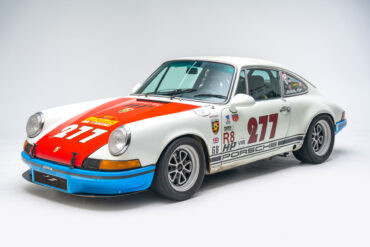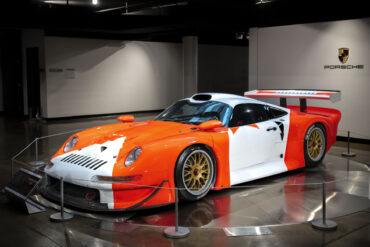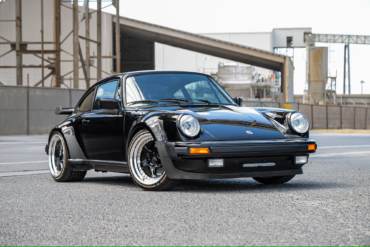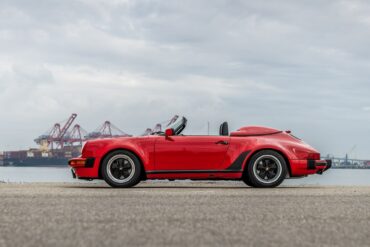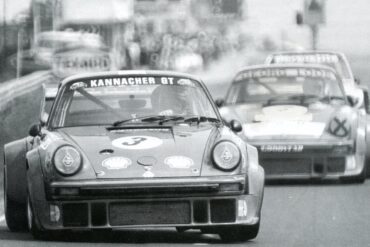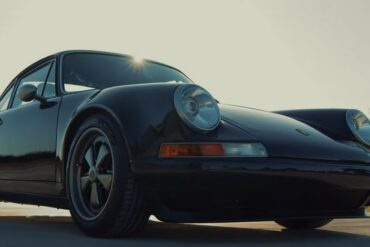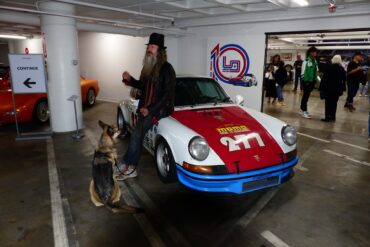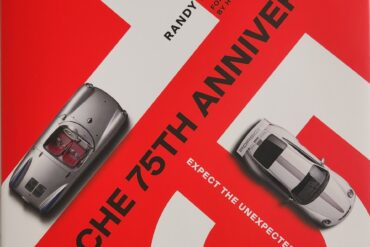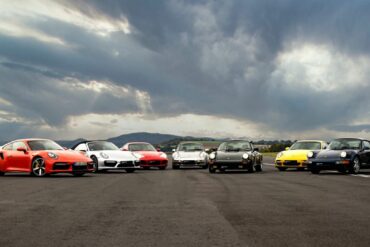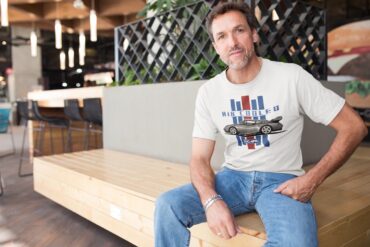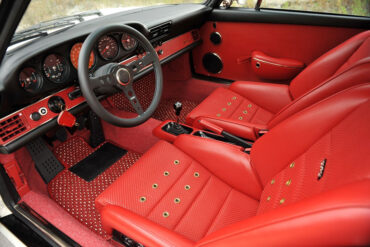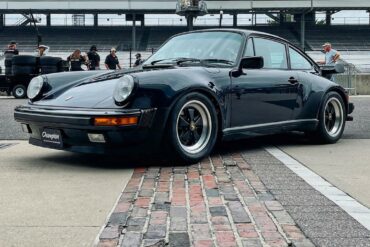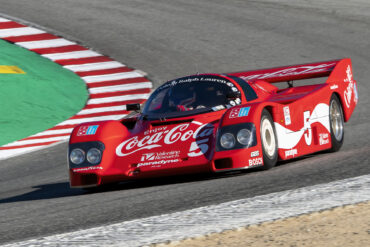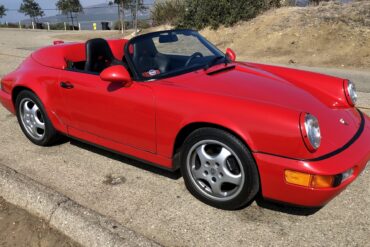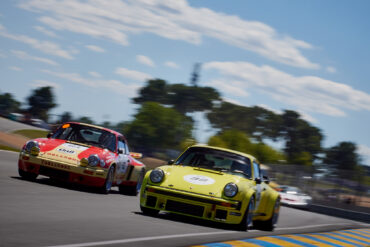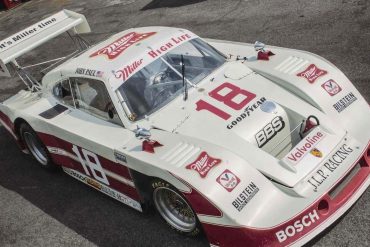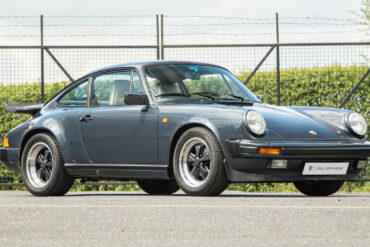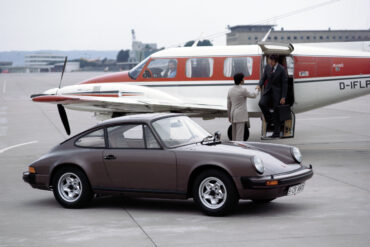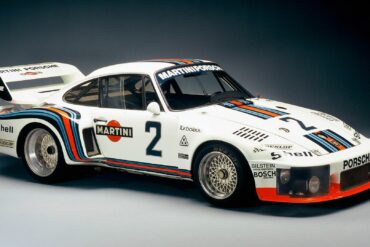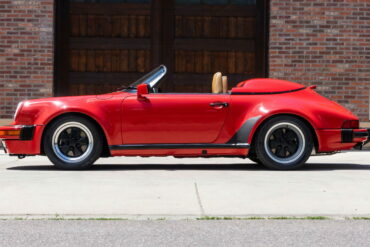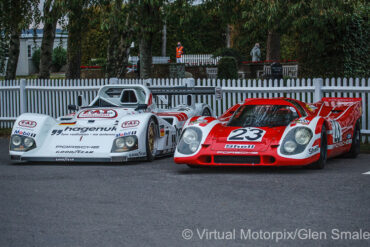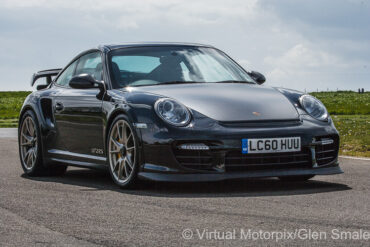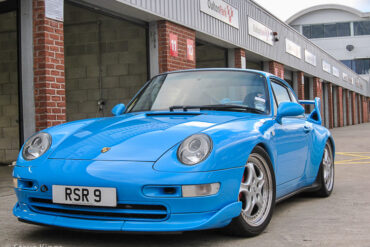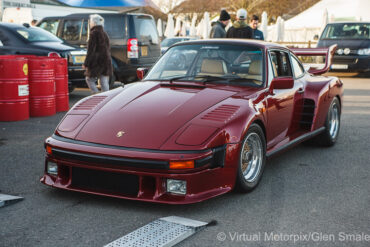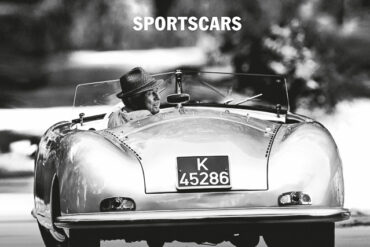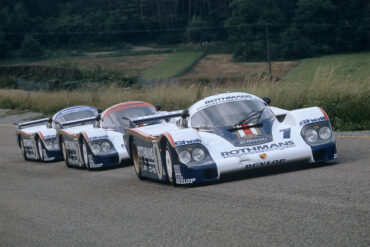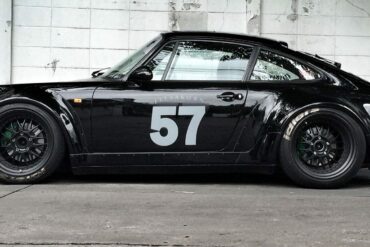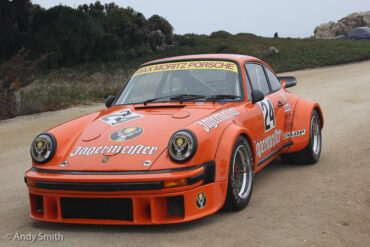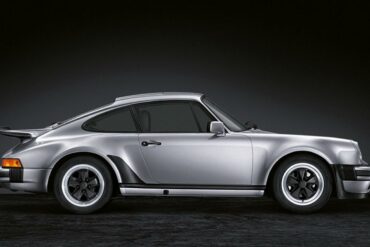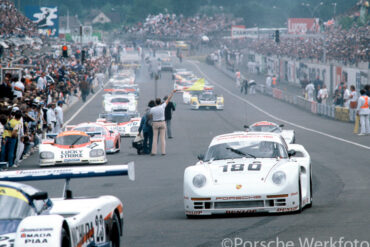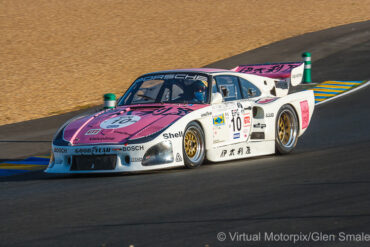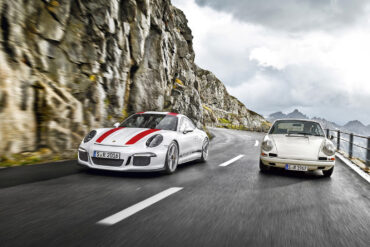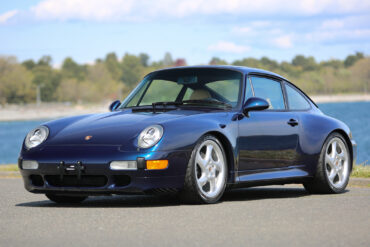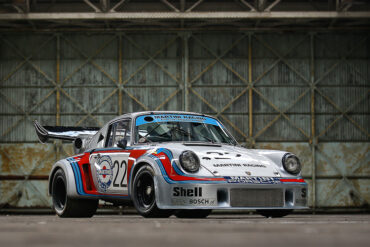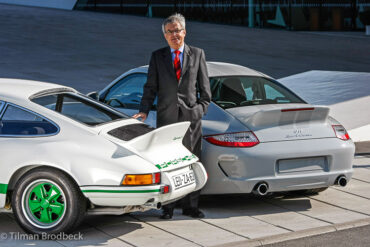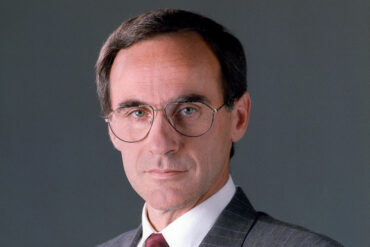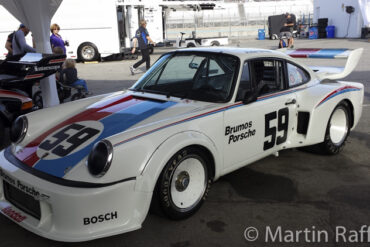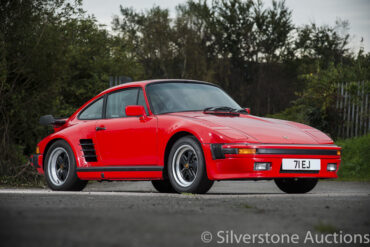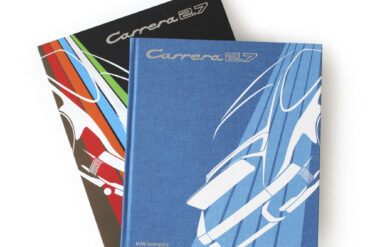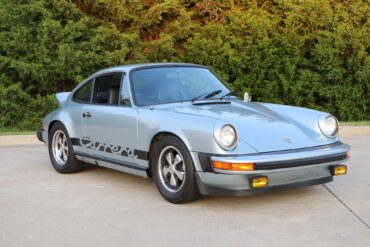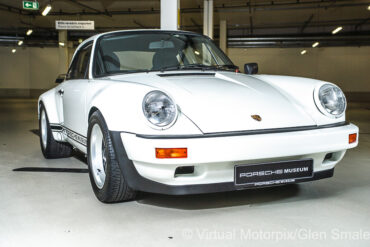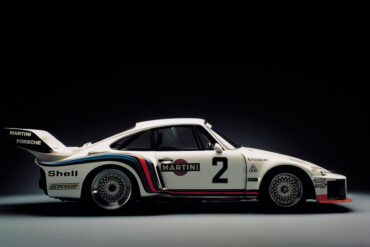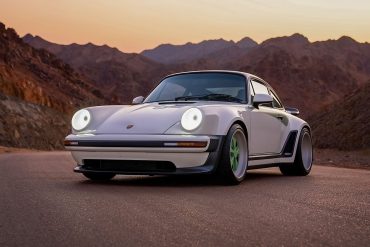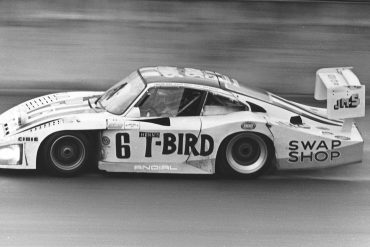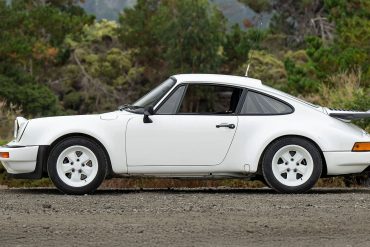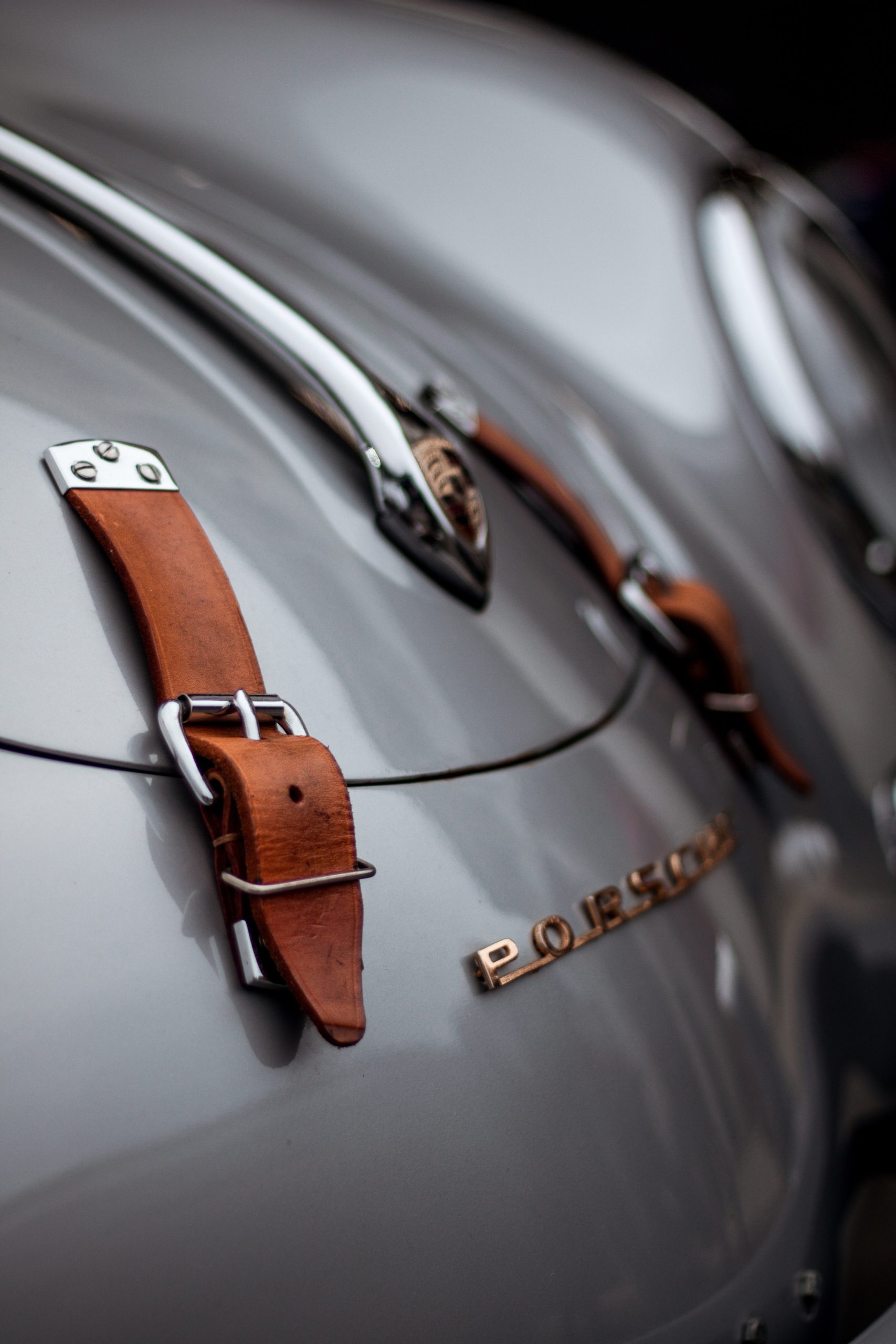The current Turbo S comes with an all-new, 3.8 liter boxer six with two variable turbine geometry (VTG) turbochargers. The power output is a staggering 640 HP and 590 lbs-ft of torque. In keeping with previous Turbo models, the engine powers all four wheels. A new 8 speed automatic transmission with a manual mode manages the power, and can power the car to 60 MPH in a hair under a claimed 2.6 seconds. This is a staggeringly quick and capable car.
326 results for
930 Turbo
The year 1974 will be remembered for many different reasons, depending on where you were living in the world at...
Ernst Fuhrmann at the 24 Hours of Le Mans, 12 June 1977 Porsche’s first CEO is frequently maligned as the...
Turbo 3.0, by Ryan Snodgrass – © Parabolica Press Amongst its numerous attributes, Porsche sports cars have always been about...
Porsche Turbo: The Inside Story of Stuttgart’s Turbocharged Road and Race Cars – by Randy Leffingwell © Quarto Publishing Group...
Porsche upgraded the performance of its 924 with the introduction of a turbocharged model in 1979. While the lower end of the engine remained unchanged, many improvements were made to the upper end of the engine as well as the drivetrain. On the outside, the car gained alloy wheels, a distinctive NACA duct in its hood, and a rear spoiler. Horsepower increased from the naturally aspirated 125 bhp to 170 bhp in the turbo.
1974 Porsche 911 Turbo #1 chassis no. 911 560 0042. First owned by the late Louise Piëch (older sister of...
The 1989/90 change of model year saw the launch of the Porsche 911, 964 series onto the market. This 911 model was initially available as a Coupe, Targa and Convertible. From model year 1991 onwards Porsche also introduced its top-of-the-line model - the Turbo - into this series. In spite of bearing a major similarity in terms of look to the naturally-aspirated model, the extended wings remained. This meant that the new Porsche could retain its turbo look. The 964 Turbo model was the successor to the Porsche 930. The 964 Turbo was the end of an era, the last of the single turbo rear-wheel drive 911 Turbos.
This video tells the story of a Porsche 911 Turbo or better known as 930 and how its owner get...
1987 Porsche 911 Turbo ‘Flachbau’ In 1986 Porsche finally offered the slantnose, called Flachbau in German, straight from the factory....
Porsche introduced a new wide-body package option. Known as the M491 option it was commonly known as the "Turbo-Look". It gave the naturally aspirated cars the look and style of the 930 Turbo with wide wheel arches and the distinctive "tea tray" tail. It wasn't just about looks however, because M491 also got you the stiffer suspension shared with the Turbo and the superior Turbo braking system as well as the wider Turbo wheels. It was available on the Coupe, Cab and Targa.
The first road-going 911 Turbo was not the familiar 930 that entered production in February 1975. Nor was it the engine-less prototype that had appeared at the Paris Motor Show in October 1973. Instead, it was a one-off narrow-bodied mule that was subsequently gifted to Ferry Porsche’s sister, Louise, on her 70th birthday in August 1974. Built on chassis 9115600042, this 2.7 Carrera Turbo also pre-dated the prototype 930 that was shown in almost production-ready at Frankfurt show in 1974.
In the 1970s Porsche was serious about turbocharging and this prototype signaled the way for later cars like the 930 and the RSR 3.0. It was also the one of the very first show cars fitted with the wide body, large alloy wheels, whale tail and a turbocharged version of the flat-6. All these details eventually appeared on the 911 RSR 3.0-liter race car of 1974. The show car was built from a standard 911S fixed with a radical body kit.
The 911 SC effectively replaced the 911 S and was one of Porsche's first models that was meant for the international market. It was sold as a cheaper alternative to the 911 Turbo. The SC used an unblown version the 930 Turbo unit that offered 180 to 200 bhp depending on model year. Options included the rear whale tail, front chin spoiler, Bilstein dampers, 16 inch wheels with Pirelli P7 tires and sports seats. Sometimes dealers lumped these options together to create their own sport package. It was available as a Coupe and Targa from 1978 - 1983, while the Cabriolet version was only available in 1983.
For race teams and track day customers Porsche prepared a small number of the 964 Cup cars according to the FIA NG-T regulations. Officially called the Competition model, these custom-ordered cars were an intermediary step between the Carrera Cup option (M001) and the standard tourer (M002). This M0003 option was available directly from Porsche as a road-going model. These cars had almost all the Carrera Cup modifications including the new suspension. This lowered the car by 40mm in the rear and 50mm in the front. It also included fitting of the larger 930 Turbo disc brakes and adjustable anti-roll bars.
Using the 930 Turbo as a basis, Porsche built the 934 for Group 4 GT racing. It replaced the outgoing Carrera RSR while winning GT Championships in Europe and performing very well in America for Trans Am. Porsche built the 934 from a standard 930 bodyshell and production rear spoiler, but almost nothing else was left alone. The suspension was converted to solid mounts and nylon bushings with adjustable anti-roll bars.
The first prototype receiving those modifications was code named “F3”, and was destroyed in the first crash test. A total of 37 prototypes and pre-production cars were used for testing and press activities. Most of these prototypes were dismantled and discarded, but several managed to survive. In 1985, Porsche’s head of development Helmut Bott earmarked 29 930 Turbo chassis to be turned into 959 prototypes for testing.
First-hand experiences with Porsches often forge life-long bonds between the car and its owner. For some, this relationship may have...
Background & Tech In the late 1960s, as California’s new anti-smog legislation became operative, it was apparent that highly tuned...
In this concluding article, we cross the 150k price barrier where the atmosphere becomes more rarified. Our upper limit of...
Ever since Pong and PacMan came out over 40 years ago into the brand new “video game arcades” of the...
With our latest price limit, we are well beyond the new price of virtually any 718 Boxster/Cayman – the double...
This 1970 Porsche 911 S, originally used in SCCA/Team Continental autocross and track events, was upgraded to RSR specifications by...
A perfect parade of pristine Porsche 911’s is set to be a star draw at the Salon Privé Club Trophy...
Originally built by German tuner Gemballa, the Avalanche was more than just a cosmetic upgrade. Boasting a powerful single-turbo engine...
Like a few other brands, Porsche was formed many decades ago not so much to build the perfect road car,...
In model year 1978, the 911 model range was reduced to two models. The 911 SC (Super Carrera) took the...
If you were lucky enough to visit Rennsport Reunion 7 in Monterey, California, then chances are you gazed at one...
This 1979 Porsche was originally a 930 Turbo coupe before it was transformed and modified into a 911 RSR Tribute...
The Porsche 934, first introduced in 1976, was the Group 4 GT race version of the Typ 930 Turbo road car....
The Audiobahn E8: Porsche in the 90’s Welcome to The Audiobahn, the Stuttcars.com podcast focused on all things Porsche. In our...
The origins of this 1989 Porsche DP 935 Long Windshield lie in the iconic 935 race car, a dominant force in...
British automotive engineering specialist, Lanzante, will once again deliver a stellar line-up for the Goodwood Festival of Speed. No less...
This 1975 Porsche 911S Coupe underwent an extensive restoration project. The car’s bodywork was chemically stripped and sandblasted, and various...
History Long regarded as the best entry-level air-cooled 911, the Carrera 3.2 remains highly desirable. It was the final evolution...
Magnus Walker’s popular YouTube series, “Other Peoples Porsche,” explores unique and fascinating Porsche cars across the country. From a 1969...
The RUF CTR was first introduced in 1987 as a modified version of Porsche’s 3.2 flat six. It features a...
No matter who you are or where you’re from, there are three things that connect everyone that is reading this...
If there is one thing that can be said about those who are enthusiastic about, or even own, a car...
Overview of the Porsche 718 Revealed in 2016, the Porsche 718 was the third generation Boxster/Cayman. Strictly speaking, it was...
Overview The GT3s are the low volume 911s, road-going production cars homologated for what was Group 3 competition. The original...
It took Porsche twenty years before deciding to modernise its 911, yet outwardly, apart from its bumpers, the new 964...
Reviewed & Edited by Rex McAfee Only in SoCal: The Urban Outlaw Last year, to commemorate the 10th anniversary of...
Unlikely Home for a Spectacular Collection: Remember the days of going to a Porsche dealership as a teen? How could...
Collecting Cars is proud to offer a striking example of a 1978 Porsche 911 3.0 SC featuring an all-black colour...
The 1989 model of Porsche’s 911 Speedster model lineup is arguably one of the most recognizable as the 911 Speedster...
1976 saw 31 customer 934 cars built. Chassis numbers run from 930 670 0151 to 0180 (plus 930 670 0540)....
UK-based Theon Design firm is a small shop that is currently in the spotlight for their partially carbon fiber-bodied Porsche...
All photos by the author and courtesy Magnus Walker. Magnus Lucian Titus Bennett Walker is known for many things, and...
Although a relatively late starter compared to others in the 20th century, what Porsche has accomplished over its 75-year history...
There’s hardly a brand more connected to sports cars than Porsche. To this very day, the iconic Porsche 911 remains...
If you can’t own a Porsche of your own (and even if you can), repping Stuttgart and its world-famous automobiles...
Images courtesy of CocoMats.com. For those that collect Porsches and need to replace old bits, have a restoration 911 in...
Three classic Porsche sports cars were showcased at the Winner’s Circle at Indianapolis Motor Speedway (IMS) as the regional finalists...
Sorry, but you do not have permission to view this content....
Note: Some images from this article provided by Roger Katz. The Type 964 Porsche 911 was a revolutionary car when...
Sorry, but you do not have permission to view this content....
There are 935s, and then there are 935s… Although almost a hundred Porsche 935s were built between 1975 and 1984,...
The replacement for the SC series came in 1984 as the 911 3.2 Carrera, reviving the Carrera name for the first time since 1977. This was the last iteration in the original 911 series, with all subsequent models featuring new body styling and new brake, electronic, and suspension technologies. Almost the same galvanised body as the SC. Engine was claimed to be 80 per cent new, and the first production 911 to feature an ECU to control the ignition and fuel systems.
As a successor to the Carrera 2.7 MFI, the Carrera 3.0 was fitted with a variation of the 930's engine without a Turbo. During its production period only 3,687 cars were made. The Carrera 3.0 was replaced by the Porsche 911 SC for model year 1978. Between 1976 and 1977, Porsche introduced the Carrera 3.0 with wide rear flares, optional whale-tail, and other luxury options. Built before the ‘911 SC’ it has everything the SC has, and more. It’s a different drive with more power @200bhp; more torque @188 ft/lb @4200rpm and it was 10% lighter too.
Porsche 935 The Ultimate Model Guide From 1977 into the 1980s, Porsche 935s were the popular choice in Group 5,...
Essentially a Carrera 3.2 with a chopped, more steeply raked windscreen and hood, plus a stripped-out interior. Most had wide Turbo bodies. Porsche insisted that the simple hood was not designed to be 100 per cent watertight. The first Porsche 911 Speedster was built in 1989 and it was the last vehicle with the old 911 body. Three decades passed before the Speedster made a comeback. Had a 3.2 L Aircooled Flat 6 and 2274 were produced for the 1989 model year.
(From L-R) 1995 Porsche WSC-95 in which Tom Kristensen registered his first Le Mans win (1997) and the first Porsche...
2010 Porsche 911 GT2 RS (Type 997), Llandow Circuit, Cardiff, Wales, UK (2014) The GT2 has been Porsche’s top performing...
Porsche 993 Carrera RS ‘RSR 9’ parked in the pit lane at the 10th RS Track Day Oulton Park, March...
A huge banner adorns the side of this high bay warehouse in Werk 2, announcing the 25th anniversary exhibition of...
The Complete Book of Porsche 911 – Every Model Since 1964 by Randy Leffingwell: © Quarto Publishing The name, Randy...
70 Years of Porsche Sports Cars – Edition Porsche Museum – © Delius Klasing Published in recognition of the company’s...
The ‘white, red and blue’ 956 LHs line up at Weissach ready for their onslaught at the Le Mans 24-Hour...
The Pinnacle of Porsche Tinkerers, Here is Our List of The Best Restomod & Porsche Restoration Shops Our interest in...
Jägermeister Porsche 934 chassis #930 670 0167 The Jägermeister 934 is one of the most recognisable liveries in the world...
The Evolution of the Porsche 911 Porsche 911 Generations First Generation (1963-1989) Porsche 964 (1989-1994) Porsche 993 (1994-1998) Porsche 996...
Group shot of (from L-R): Porsche 959 Paris-Dakar rally car; 959 road car; 961 race car (1986) The Porsche 961...
The All Time Greats – 70 Best Porsches of All Time (Ultimate List) Clearly we have been a bit of...
Porsche has made a lot of cracking 911s over 50+ years. We Pick the Best Production, Limited Edition & Race...
1974 Porsche 911 Carrera RSR Turbo: Courtesy of Gooding & Company – ©Mathieu Heurtault Three historic turbocharged competition Porsches are...
Tilman Brodbeck poses with a 1973 911 Carrera RS 2.7 Coupé (left) and a 911 Sport Classic (right) – 21...
Dr. Ulrich Bez (1988) Hailing from the Bad Cannstatt district of Stuttgart, Ulrich Bez, who as Porsche Technical supremo hatched...
This is the Peter Gregg car (chassis #930 770 0952) as shown at the Porsche Rennsport 2015. In early 1977,...
Porsche 911 (930) Turbo SE – 1989 MY A couple of world records were set at the Silverstone Auctions’ NEC...
Blue cover – Limited Edition Much has been written about the Porsche 911, in fact there are few manufacturers in...
In 1974, Porsche's performance version of the 911 was simply known as the 911 Carrera. It had new bumpers that complied to American regulations and the 2.7-liter engine from the Carrera RS 2.7. Other new features for 1974 included new seats, a full-width rear taillight. The Carrera deleted all the chrome off the car in favor of black window frames, wipers, doorhandles, but chrome could be ordered as an option. In 1976 Porsche replaced the Carrera with a new 3.0 liter variant.
Built so that the factory Rothmans Porsche Rally Team could hit the international stage, the SC RS used the Turbo’s body with fibreglass bumpers and aluminium doors. In Autumn 1983, Porsche presents the 911 SC/RS for motor racing. The engine originates from the 911 SC, with improved performance achieved by the mechanical ball fuel injection, increased compression, the cylinder heads from the 935 and forged pistons. Racing seats are fitted in place of the standard seats.
The Group 4 racer based on the 911 Turbo (930) was called 934 and the Group 5 Porsche was called 935. The first version of the 935 looked similar to the 911 Carrera RSR. The first customers for 935 were Martini Racing and Kremer Racing. The Martini car was a full factory development, while Kremer made its own enhancements already before the first race. By 1977, the 935 was sold as a customer car for these series to race against cars like the BMW CSL.
Recognized worldwide for its “reimaginations” of the air-cooled Porsche 911, Singer Vehicle Designs has announced the appointment of Seven Car...
New Second Gen With a sharper design, more power, more range, and even better charging performance, Porsche extensively modernized the...
For the 10th time, the Porsche magazine ORIGINALE invites readers to dive into the fascinating world of classics. This special...
The Specialty Equipment Market Association (SEMA) hosts one of the world’s largest automotive trade shows each year in Las Vegas,...
Reimagined as the all-electric “E Porsche 911,” this 1976 widebody Porsche 911 is a striking example of how historic icons...
From 1977 through the 1980s, Porsche 935s dominated Group 5, GTP, and GTX racing across Europe and North America. With...
The Porsche 911, with its distinctive rear-engine layout and flat-six boxer engine, has been a cornerstone of the sports car...
In the 50th anniversary year of the 911 Turbo, Luftgekühlt returned to Los Angeles at the weekend to host a...
911 “Evolutionsserie” Unless you’re attending Luftgekühlt, a 000 event, or perhaps a special Porsche collection visit, a discussion of the...
Background Tartan fabrics symbolize tradition and craftsmanship, belonging, and confidence. Exactly 50 years ago, three tartans were on the options...
Held during Monterey Car Week, The Quail, A Motorsports Gathering, has become one the world’s most prestigious automobile events. No...
50 Years and counting Fifty years of Turbo – the model designation that has produced some of the most capable...
It’s always the same with sports cars from Zuffenhausen: they’re easy to start and well-suited for comfortable travel. However, with...
Focused Marketing While automakers continue to scale back their presence at traditional auto shows, their investment in “focused customer” lifestyle...
When you have a company as storied as Porsche, with enthusiasts at every corner of the globe, some of those...


